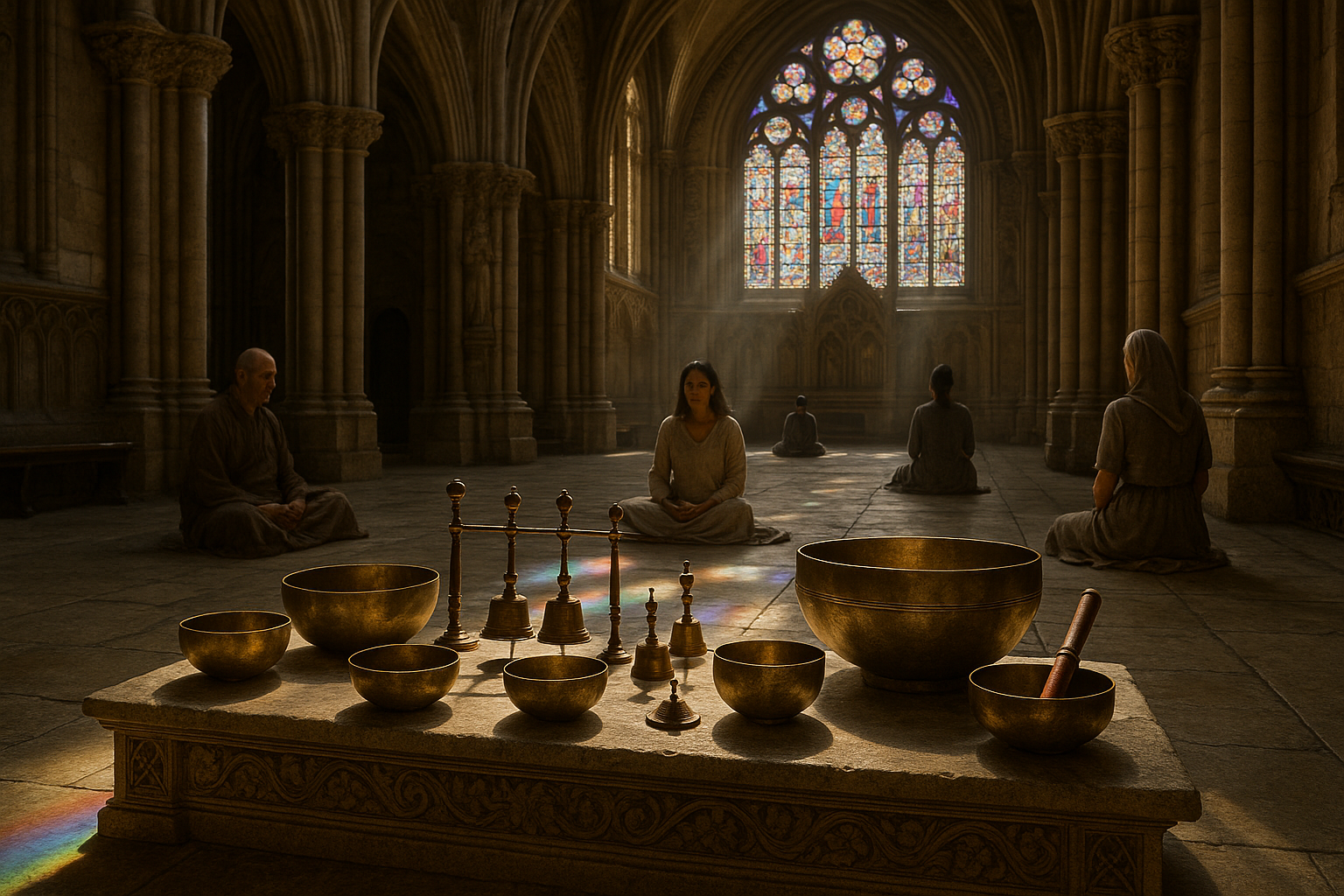Imagine stepping into a space where every element, from the layout to the materials, is meticulously designed to resonate with your very being. A place where the architecture itself seems to hum with an invisible energy, creating an atmosphere of tranquility and inspiration. Welcome to the world of sacred architecture, where the power of vibrations and their impact on our surroundings are harnessed to create harmonious spaces that elevate the human spirit. 🌟
Sacred architecture is not just about grand cathedrals or ancient temples; it is an exploration of how structures can be designed to foster spiritual well-being and connectivity. At its core, this architectural approach seeks to create environments that are not only aesthetically pleasing but also imbued with a deeper sense of purpose and harmony. In our modern world, where stress and chaos often reign, the idea of finding solace in spaces that nurture our inner peace is more relevant than ever.
But what exactly gives sacred architecture its unique power? The answer lies in the profound understanding of vibrations and their ability to influence our emotional and physical states. Everything in the universe, including ourselves, is in a constant state of vibration. These vibrations can either harmonize with our natural frequencies, creating a sense of peace, or disrupt them, leading to discomfort and disarray. Sacred architecture aims to align with these frequencies, using design elements that enhance positive vibrations and mitigate negative ones.
Throughout history, civilizations have recognized the significance of these vibrational energies in their sacred spaces. From the intricate geometric patterns of Islamic mosques to the soaring spires of Gothic cathedrals, architectural elements have been deliberately chosen to evoke specific feelings and states of consciousness. The ancient builders understood that the spatial dimensions, materials, and even the orientation of a structure could significantly impact its vibrational quality.
In this blog post, we will delve into the fascinating world of sacred architecture and explore how it uses vibrations to create spaces of profound beauty and spiritual resonance. We’ll uncover the historical roots of this architectural approach and examine its evolution over time. 🏛️ Our journey will take us through various cultures and traditions, each contributing its unique perspective on harmonizing spaces.
Moreover, we will discuss the modern applications of these age-old principles in contemporary design. As sustainability becomes an ever-pressing concern, architects are increasingly looking to sacred architecture for inspiration in creating spaces that are not only environmentally friendly but also spiritually uplifting. We’ll explore how elements like natural light, acoustics, and spatial geometry are being used in innovative ways to enhance the vibrational quality of modern buildings.
Additionally, we’ll address the science behind vibrations and their effects on human psychology and well-being. Recent studies in fields such as quantum physics and psychoacoustics have begun to unravel the mysteries of how certain frequencies can alter our mood, perception, and even our physical health. This research provides a scientific foundation for the principles that sacred architects have intuitively applied for centuries.
As we navigate through these themes, we will also offer practical insights for those interested in incorporating elements of sacred architecture into their own living and working environments. Whether you’re an architect seeking inspiration for your next project or simply someone interested in enhancing the energy of your personal space, there are tangible steps you can take to create a more harmonious environment. 🌿
The power of sacred architecture and its focus on vibrations offer a compelling framework for understanding how our environments shape our lives. By embracing these principles, we can create spaces that not only meet our functional needs but also nourish our souls and foster a deeper connection to the world around us. So, as we embark on this exploration of harmonizing spaces, let’s open our minds and hearts to the transformative potential of vibrations in architecture.

Conclusion
In wrapping up our exploration of Harmonizing Spaces: The Power of Vibrations in Sacred Architecture, we have traversed the fascinating intersection of architecture, spirituality, and science. From ancient temples to modern places of worship, the intentional use of space and vibration has proven to be a powerful tool in shaping human experience and connection to the divine.
Throughout this article, we delved into historical examples of sacred architecture, demonstrating how civilizations across the globe have harnessed the power of acoustics and geometry to enhance spiritual practices. The Great Pyramid of Giza, the Temple of Heaven in Beijing, and the majestic Notre-Dame Cathedral in Paris serve as testaments to this enduring tradition. Each of these architectural marvels was designed with an acute awareness of how physical space can influence spiritual energy and human emotion. 🏛️✨
Modern science has begun to catch up with these ancient insights. Research in fields like acoustics and physics has uncovered how specific frequencies and vibrations can affect our mental and emotional states. This emerging understanding validates what ancient builders intuitively grasped: that sound and space can harmonize to create profound experiences of peace and transcendence.
The importance of this topic extends beyond historical and architectural interest. In our fast-paced modern world, creating spaces that promote calmness and spiritual well-being is more crucial than ever. Whether in our homes, workplaces, or public buildings, applying principles of sacred architecture can lead to environments that nurture our mental and emotional health. 🧘♂️
We encourage you, dear reader, to reflect on the spaces you inhabit daily. Consider how the principles of sacred architecture might be employed to transform these environments into sanctuaries of tranquility and inspiration. By paying attention to elements such as light, sound, and geometry, we can all create spaces that resonate with harmony and purpose.
If this topic has sparked your interest, why not take it further? Share this article with friends or family who might find it intriguing. Comment below with your thoughts or experiences related to the vibrations of space. How have certain environments impacted your sense of peace and connection? We’d love to hear your stories and insights. 🌟
As we continue to explore the power of architecture in shaping our world, may we strive to create spaces that resonate with both beauty and meaning. Let’s build not just structures, but environments that elevate the human spirit and foster a deeper connection with the sacred.
This conclusion provides a summary of key points, emphasizes the relevance of the topic, and encourages engagement, all while maintaining a professional and inspiring tone.
Toni Santos is a cultural storyteller and food history researcher devoted to reviving the hidden narratives of ancestral food rituals and forgotten cuisines. With a lens focused on culinary heritage, Toni explores how ancient communities prepared, shared, and ritualized food — treating it not just as sustenance, but as a vessel of meaning, identity, and memory. Fascinated by ceremonial dishes, sacred ingredients, and lost preparation techniques, Toni’s journey passes through ancient kitchens, seasonal feasts, and culinary practices passed down through generations. Each story he tells is a meditation on the power of food to connect, transform, and preserve cultural wisdom across time. Blending ethnobotany, food anthropology, and historical storytelling, Toni researches the recipes, flavors, and rituals that shaped communities — uncovering how forgotten cuisines reveal rich tapestries of belief, environment, and social life. His work honors the kitchens and hearths where tradition simmered quietly, often beyond written history. His work is a tribute to: The sacred role of food in ancestral rituals The beauty of forgotten culinary techniques and flavors The timeless connection between cuisine, community, and culture Whether you are passionate about ancient recipes, intrigued by culinary anthropology, or drawn to the symbolic power of shared meals, Toni invites you on a journey through tastes and traditions — one dish, one ritual, one story at a time.




